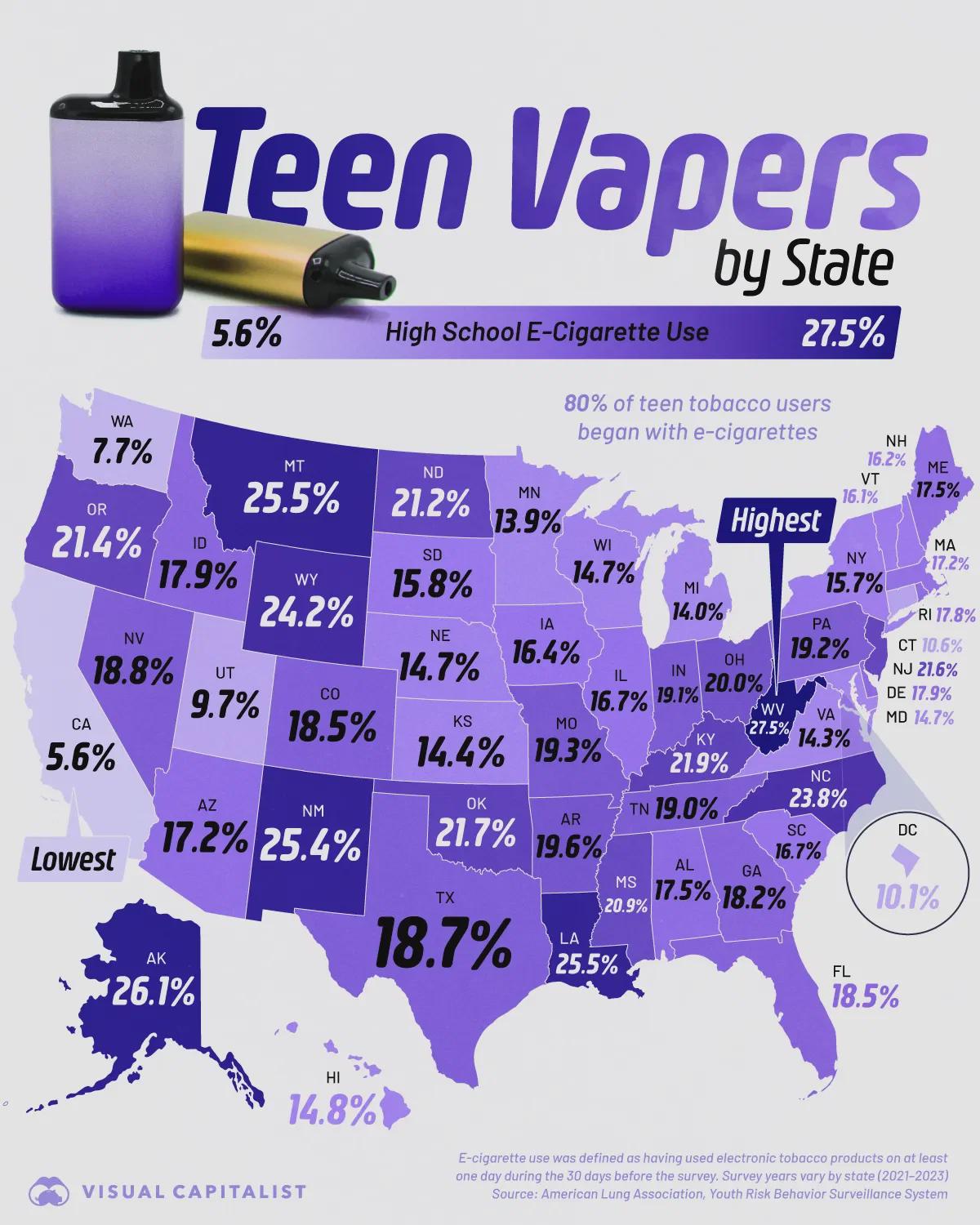Teen Vaping Rates by U.S. State Map


Marcus Rodriguez
Historical Geography Expert
Marcus Rodriguez specializes in historical cartography and geographic data analysis. With a background in both history and geography, he brings unique...
Geographic Analysis
What This Map Shows
The "Teen Vaping Rates by U.S. State Map" provides a clear visual representation of where the highest concentrations of teenage vapers are located across the United States. This map highlights not only the states with the most significant percentages of teens engaging in vaping but also underscores the broader implications of this trend on public health and policy. Such a visualization is essential in understanding both the geographical distribution and the social factors contributing to vaping among adolescents.
Deep Dive into Teen Vaping
Teen vaping has become a significant public health concern over the past few years. The rise of e-cigarettes and vaping products has led to an increase in usage among youth, raising alarms among health professionals and educators alike. What’s fascinating is that the vaping phenomenon among teens is not uniform across the country; it varies significantly by region, state, and even within local communities.
According to the latest statistics, approximately 19.6% of high school students reported using e-cigarettes in the past month, a figure that has sparked numerous discussions about the implications of vaping on youth health. Interestingly, the reasons behind this trend are multifaceted. Some studies suggest that peer influence, marketing strategies targeting young people, and the perception of vaping as a safer alternative to traditional cigarettes may contribute to its popularity.
Moreover, the chemical composition of vape liquids often includes nicotine, which is highly addictive and can have detrimental effects on brain development in teenagers. According to the Centers for Disease Control and Prevention (CDC), nicotine can harm the parts of the brain that control attention, learning, and impulse control, which is particularly concerning given that the adolescent brain is still developing.
In examining the specific states represented in the map, we find that areas with higher teen vaping rates often coincide with states that have less stringent regulations on e-cigarette sales and marketing. For instance, states like Arkansas and Utah have been reported to have some of the highest rates of teen vaping, reflecting a combination of accessibility and cultural acceptance. Conversely, states that have implemented rigorous regulations—like California—show lower rates, suggesting a correlation between policy and usage.
Regional Analysis
When we break down the map by regions, we observe some intriguing patterns. The Midwest, for example, seems to have a higher prevalence of vaping among teens compared to the Northeast. In states like Michigan and Ohio, factors such as socioeconomic status and urbanization may play a role in the increased usage rates. Urban areas often have more accessible vape shops and a more significant presence of vaping culture, which can lead to higher rates of experimentation among teens.
The South exhibits a mixed bag; states like Kentucky show high vaping rates, while others like Florida have seen more successful public health campaigns to deter teen vaping. Interestingly, some Southern states have also faced legislative challenges when attempting to regulate e-cigarette sales, which can lead to higher accessibility for adolescents.
In the West, states such as Washington and Oregon demonstrate a unique approach with more comprehensive education and prevention programs aimed at teens. These states are leading the charge in public health initiatives that target vaping, potentially explaining their lower teenage vaping rates compared to other parts of the country.
Significance and Impact
Understanding the geographical distribution of teen vaping is crucial for several reasons. First and foremost, it informs public health initiatives and policy-making. As the map highlights, regions with high rates of teen vaping may require targeted interventions, such as educational campaigns or stricter regulations on e-cigarette sales. The disparities shown in the map also raise questions about equity in health access; some states may have more resources to combat vaping than others.
Moreover, as vaping technology continues to evolve and new products enter the market, ongoing monitoring of trends will be essential. What’s alarming is that the long-term health effects of vaping are still being studied, and the full extent of its impact on the youth population remains to be seen. Future projections suggest that if current trends continue, we may see an even greater rise in nicotine addiction among teens, which could lead to a host of health issues down the line.
In conclusion, the "Teen Vaping Rates by U.S. State Map" serves as a powerful tool for understanding the complexities of youth vaping across the nation. By examining this data, we can better equip ourselves to tackle the challenges posed by vaping and foster a healthier future for our youth.
Visualization Details
- Published
- September 28, 2025
- Views
- 30
Comments
Loading comments...